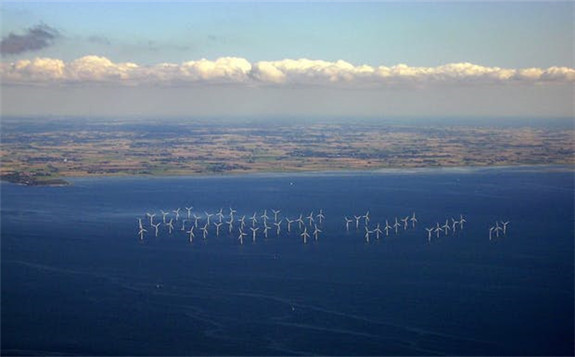Higher capacity wind turbines, advanced drone technology, big data and machine learning - the costs of developing, deploying, and maintaining ever more efficient offshore wind energy projects continue to decline, helping to reduce the cost of clean energy economy.

When Vattenfall's wind deployment center off the cost of Scotland came online in late 2018, it marked the "birthday" of some of the largest operational wind turbines in existence. But even though these are impressively huge machines we're talking about here, the site is also a testing ground for some of the most promising cost-cutting techniques and technologies for offshore wind energy.
Let's take a look at some of those technologies right now and what they mean for the ongoing adoption of clean energies and the future of our planet.
Higher-Capacity Wind Turbines
The size of the turbines at Vattenfall is an advantage, rather than a liability. Tom Harries, representing Bloomberg New Energy Finance in an interview, observed that increasing the maximum capacity of a wind turbine — the amount of power it's designed to generate — could impact the cost of operations and maintenance for offshore energy projects by as much as 60 percent.
Similarly to how the primary challenge driving competition in the solar market is increasing the efficiency of solar cells, the same can be said about wind turbines. In fact, Vattenfall already has its eyes on even bigger turbine designs — GE's "Haliade-X" — for future deployments.
Why does bigger equal better, in terms of costs? It's simple: per megawatt (MW) of power generated, larger-capacity turbines cost less to operate and maintain. These savings come from lower personnel requirements, fewer trips by vessel, lower spending on spare parts and more.
Drones and Remote Maintenance
In addition to pursuing newer turbines designed for capacity and efficiency, energy companies can also invest in technologies that make operations and maintenance tasks cheaper and more convenient to complete.
One of these technologies is drones. Remotely operated drones can help maintenance crews perform inspections more safely and in far less time than before, even while working at height and even when extremely imposing structures are involved. Drones represent the future of remote inspections and even repairs, thanks to the ability for some models to navigate even in very challenging environments.
Adding to fleets of aerial drones, submersible drones allow safe viewing of the underwater portions of wind turbine towers as well as expedient inspections of intakes and reservoirs on dams. Remote-controlled drones aren't replacing humans in energy infrastructure maintenance, at least not in significant numbers, but they're definitely giving their human counterparts a different perspective and helping more of them keep their feet on solid ground.
Analytics and Predictive Maintenance
How do designers and manufacturers in the energy sector keep on delivering design improvements that yield higher efficiency and performance but consistently lower costs? One way is analytics. By collecting exhaustive amounts of data with sensors, on critical parts and entire offshore installations, engineers can iterate on their own designs to correct for maintenance pain points (to drive down O&M prices further) as well as help address shortcomings and inefficiencies in operations and to pursue even lighter and cheaper-to-install designs for future products.
Long before this analytical data is put to work in product R&D, however, it's useful as part of a real-time and predictive maintenance program for offshore energy installations. The data being gathered on turbine performance can reveal when a part is about to fail, before it actually does, meaning crews can avoid extremely expensive downtime during peak generating hours. Changes in temperature, vibration and even sounds given off by individual parts, and where multiple parts interact with one another, can signal problems with mechanical structures.
Applying the Industrial Internet of Things to the energy sector means maintenance crews can engage in remote monitoring and data-gathering, and then apply machine learning models to test real-time data against known benchmarks for machine health. The result is one step beyond of preventive maintenance (which still might cause unwanted downtime) — it's truly predictive maintenance, courtesy of Big Data.
Big Data and analytics will help operators of offshore energy sites save money by avoiding equipment failure and unnecessary downtime, extending the lifetime of individual parts by monitoring their health and running them for longer, allowing smaller numbers of managers and engineers to operate and maintain multiple installations from a central operating location, and by making it less likely that an energy company will have to fall back on dirty energy generation to meet demand.
In short, there are lots of exciting ways under active development, or already available, that can help energy companies bring down costs in the offshore energy market. And lower costs in clean energy is a win for the rest of us — and for the planet.